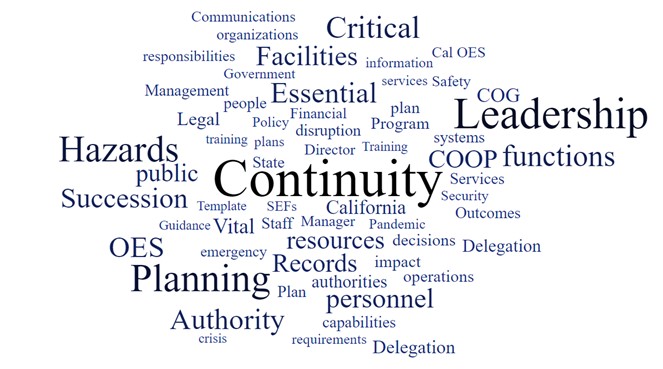Continuity Planning
Continuity is the ability to ensure the continuation of an organization’s essential functions and to provide uninterrupted services during emergencies of all-hazard types or any situation that may disrupt normal operations. The goal of Continuity Planning is to ensure that the State of California can continue its vital governmental services and operations under all conditions. For this to take place, state and local agencies and departments must have plans in place to carry out their essential functions without interruption to essential services.
This webpage provides Continuity Planning Guidance and Resources to local, state, and tribal governments, agencies, departments, and organizations. These efforts include the following:
Continuity Program Assessment Tool (CPAT)
POETE-based Continuity Self-Assessment
New Submission Schedule
2024-2025 SIMM 5330-C
Continuity Training
View upcoming continuity trainings and annual workshops
FEMA Continuity Resource Toolkit
FEMA Continuity Doctrine, NCTP, Template, and Resources
Learn more about the 2025 CPAT launch: Download the Virtual Statewide CPAT Workshop slide deck here
Video recording will be posted early Jan 2025.
Continuity References and Resources
Continuity Planning for State Agencies and Departments
CPAT Signature Page The California Continuity Planning Guidance and Plan Template provides direction to state agencies and departments in developing their continuity plans and programs. The Governor, through Executive Order S-04-06, expressed his commitment to ensuring that Executive Branch agencies and departments are ready to respond and recover from natural and man-made incidents. Based on the Executive Order’s reference to “update Continuity of Operations Plans and Continuity of Government (COOP/COG) Plans,” the ongoing expectation is state agencies and departments will continue to revise and maintain their plans. As a result, Cal OES offers guidance and tools to enable executive branch agencies / departments to enhance and maintain their continuity plans.
The planning resources and tools included in this program can be used whether an organization is starting from the very beginning of the planning process or merely updating plans already in place. However, Executive Order S-04-06 requires that the plans developed or updated by state agencies and departments be consistent with the guidelines promulgated by CAL OES.
To ensure capability in all the key planning element areas, a Continuity Plan Evaluation Checklist has been created and included in the Continuity Planning Guide. The Continuity Plan Evaluation Checklist is a self-certification that has been developed to help maintain a continuity plan that reflects the most current state/federal continuity planning standards. The Checklist documents the organization’s Continuity Program and Plan status.
Beginning in 2010, the Continuity Plan Evaluation Checklist is to be completed by the agency’s continuity planning team and signed by the secretary/director. The Continuity Plan Approvals page is used to indicate that the organization’s senior level officials have read the Continuity Plan and understand their roles and responsibilities should the organization’s business essential functions be disrupted. The Checklist should then be mailed to CAL OES according to the Continuity Planning Guidance Document. Schedule for submission is contained within the guidance and provided for quick reference below.
State Agencies & Departments Resources:
Pandemic Planning
Pandemic influenza demands an additional set of Continuity planning considerations. Unlike traditional Continuity planning, pandemic influenza may be widely dispersed geographically and will potentially arrive in waves that could last several months at a time. While a pandemic will not directly damage facilities, power lines, banks or computer networks, it will ultimately threaten all critical infrastructure by removing essential personnel from the workplace for weeks or months. This makes a pandemic a unique circumstance necessitating a strategy that extends well beyond the public health and medical considerations, to include the sustainment of critical infrastructure, private-sector activities, the movement of goods and services across the nation and the globe, and economic and security considerations.
State agencies are encouraged to develop an annex to their existing Continuity plans that adequately address issues such as increased absenteeism, social distancing procedures, and impacts on interdependencies. The resources below are some of the best examples for guiding an organization in developing and formalizing a strategy for responding to a public health emergency.
Continuity Pandemic Resources:
For additional information please contact the Cal OES Continuity Planning Team.
Email: Continuity@caloes.ca.gov
Matt Cadrett
Senior Emergency Services Coordinator
Office: (916) 364-4517
Isamar Garcia
Senior Emergency Services Coordinator
Office: (916) 845-8796

